Underwater Acrobats: The Surprising World of Seahorse Locomotion
Seahorses have long captivated our imagination with their unique appearance and graceful movements. But beneath the surface lies a fascinating world of underwater acrobatics that few truly understand. This article delves into the intricate mechanics of seahorse locomotion, revealing how these enchanting creatures navigate their aquatic realm with surprising agility and efficiency.

The Vertical Virtuosos of the Sea
Seahorses stand out in the aquatic world for their distinctive upright posture. Unlike most fish that swim horizontally, seahorses maintain a vertical position in the water column. This unusual orientation is made possible by their unique body structure, featuring a curved spine and a prehensile tail that allows them to anchor themselves to seagrass or coral.
Their vertical stance offers several advantages. It enables seahorses to blend seamlessly with their surroundings, providing camouflage from predators and prey alike. Additionally, this position allows them to scan their environment more effectively, with their independently moving eyes constantly on the lookout for potential food or threats.
The Power of the Dorsal Fin
At the heart of seahorse locomotion is the dorsal fin, a small but mighty appendage located on their back. This fin beats at an astounding rate of up to 35 times per second, creating a rapid undulating motion that propels the seahorse through the water. The speed and precision of this movement are crucial for these relatively slow swimmers, allowing them to maneuver with surprising agility in their complex reef environments.
Research has shown that the dorsal fin of seahorses is a marvel of biological engineering. Its unique structure and flexibility enable it to generate thrust in multiple directions, giving seahorses the ability to move forward, backward, up, and down with remarkable control.
Tail Tales: More Than Just an Anchor
While the prehensile tail of a seahorse is primarily known for its gripping ability, it also plays a vital role in locomotion. The muscular tail acts as a rudder, helping to steer and stabilize the seahorse as it moves through the water. This tail-assisted navigation is particularly useful when seahorses need to make quick turns or maintain their position in strong currents.
Interestingly, the seahorse’s tail is also involved in a unique form of locomotion called “tail-assisted swimming.” When seahorses need to cover longer distances or escape predators quickly, they can use their tail to push off from surfaces, giving them an extra boost of speed.
The Snout Snap: Lightning-Fast Predation
One of the most remarkable aspects of seahorse locomotion is their feeding mechanism. Seahorses are ambush predators, relying on stealth and speed to capture their prey. Their elongated snout, which may appear cumbersome, is actually a highly efficient feeding apparatus.
When a seahorse spots its prey, typically small crustaceans or fish larvae, it can strike with astonishing speed. By rapidly rotating their head and extending their snout, seahorses can create a powerful suction force that draws the prey into their mouth. This entire process occurs in less than a millisecond, making it one of the fastest known feeding behaviors in the animal kingdom.
Adapting to the Currents: Energy-Efficient Movement
Living in often turbulent coral reef environments, seahorses have evolved energy-efficient methods of locomotion. Rather than fighting against strong currents, seahorses use a technique called “station holding.” By anchoring themselves with their tail and positioning their body to minimize drag, they can remain in place while expending minimal energy.
This adaptation allows seahorses to conserve energy for essential activities like feeding and mating. It also enables them to thrive in habitats that might otherwise be challenging for such small, seemingly delicate creatures.
Conservation Implications of Seahorse Locomotion
Understanding the intricacies of seahorse locomotion is not merely an academic pursuit; it has significant implications for conservation efforts. As seahorse populations face threats from habitat destruction and overfishing, knowledge of their movement patterns and habitat requirements is crucial for developing effective protection strategies.
For instance, the seahorse’s reliance on specific structures for anchoring highlights the importance of preserving seagrass beds and coral reefs. Their unique locomotion also underscores the need for carefully designed marine protected areas that take into account the limited range and specific habitat needs of these fascinating creatures.
In conclusion, the world of seahorse locomotion is a testament to the incredible diversity and adaptability of marine life. From their upright swimming posture to their lightning-fast feeding strikes, seahorses have evolved a suite of locomotor strategies that perfectly suit their ecological niche. As we continue to unravel the mysteries of these underwater acrobats, we gain not only a deeper appreciation for their remarkable abilities but also valuable insights that can inform our efforts to protect and preserve these enchanting denizens of the sea.





